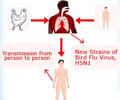An international team of researchers claims that it has unearthed evidence for the movement of Asian forms of avian influenza to Alaska by northern pintail ducks.
Evidence for the movement of Asian forms of avian influenza to Alaska by northern pintail ducks has been uncovered by an international team of researchers.
Scientists with the U.S. Geological Survey (USGS) joined forces with researchers at the U.S. Fish and Wildlife Service in Alaska and the University of Tokyo to study the role of migratory birds in the transfer of avian influenza viruses between Asia and North America.Published by the journal Molecular Ecology, their study showed that about half of the low pathogenic avian influenza viruses found in wild northern pintail ducks in Alaska contained at least one of the eight gene segments that were more closely related to Asian than to North American strains of avian influenza.
The researchers said that it was a highly pathogenic form of the H5N1 avian influenza virus that spread across Asia to Europe and Africa over the past decade, causing the deaths of 245 people and raising concerns of a possible human pandemic.
"Although some previous research has led to speculation that intercontinental transfer of avian influenza viruses from Asia to North America via wild birds is rare, this study challenges that," said Chris Franson, a research wildlife biologist with the USGS National Wildlife Health Center and co-author of the study.
He revealed that northern pintails were chosen as the focus of the study due to the fact that they are fairly common in North America and Asia, they are frequently infected by low pathogenic avian influenza, and they are known to migrate between North America and Asia.
For their study, the researchers obtained samples from more than 1,400 northern pintails from locations throughout Alaska.
The researchers said that none of the samples was found to contain completely Asian-origin viruses.
"This kind of genetic analysis - using the low pathogenic strains of avian influenza virus commonly found in wild birds - can answer questions not only about the migratory movements of wild birds, but the degree of virus exchange that takes place between continents, provided the right species and geographic locations are sampled," said John Pearce, a research wildlife biologist with the USGS Alaska Science Center and co-author of the study.
"Furthermore, this research validates our current surveillance sampling process for highly pathogenic avian influenza in Alaska and demonstrates that genetic analysis can be used as an effective tool to further refine surveillance plans across North America," Pearce added.
Based on their observations, the researchers came to the conclusion that future surveillance for avian influenza in wild birds should include the type of genetic analyses used in the current study to better understand patterns of migratory connectivity between Asia and North America and virus ecology.
Source-ANI
RAS/L
 MEDINDIA
MEDINDIA




 Email
Email




